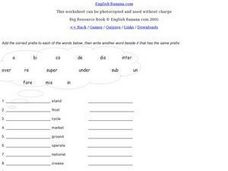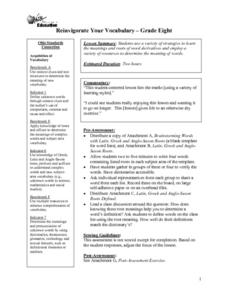Curated OER
Prefixes Aplenty
Introduce several new prefixes to your vocabulary lesson. After alphabetizing 19 prefixes, including pro-, geo-, and thermo, third graders use a dictionary to find one word that begins with each prefix. Extend the activity by having kids...
Curated OER
Adding Prefixes To Root Words
In this language arts worksheet, students examine 15 root words and add a prefix from the list to each word. Students then write another word beside it that has the same prefix.
Curated OER
It's Greek to Me!
Use Greek roots, suffixes, and prefixes to create polysyllabic words. Readers use the dictionary to identify what the word's prefix, suffix, and root or base word mean. They define what a syllable is and how one is formed using Greek...
Curated OER
Affix This
Wait, what am I supposed to affix? Explore the concept of roots/affixes with your class. They use discussion questions to discover the meaning and usage of specific roots and affixes. They watch a video explaining Latin and Greek roots...
Curated OER
Up From The Roots
Students review prefixes and root words then complete a Root Words worksheet. An answer sheet is provided with the lesson plan.
Curated OER
Roots and Affixes
Fourth and fifth graders review how words can have several parts, including; roots, prefixes, and suffixes. Pupils receive a word building tiles worksheet, embedded in the plan, and they record selected roots, prefixes, and suffixes in...
Curated OER
Identify Base Words and Suffixes to Read Multisyllabic Words #1
Show your scholars how adding an affix changes the entire meaning of a word; they focus on the suffix -able. You'll find a complete script here, but if you don't want to read this verbatim, use it simply as an outline. Learners watch you...
Curated OER
Scientific Root Words, Prefixes, and Suffixes
It's hard to imagine that anything was missed on this five-page list of science roots, prefixes, and suffixes! Listed in alphabetical order, all are included in a single, two-column list. This may be especially useful for advanced...
Florida Center for Reading Research
Vocabulary Morphemic Elements: Word Dissect
Assist pupils as they learn to separate base words and affixes and combine them to determine the meaning of words. Partners practice with cards that include words with affixes.
Utah Education Network (UEN)
Greek and Latin Roots- Introduction
Improve vocabulary by reviewing Greek and Latin roots with your ELA class! A fun and easy way for your class to memorize roots, groups are given a set of nine roots and nine definition cards which they must then match. Encourage groups...
Curated OER
SAT Preparation
The verbal and quantitative sections of the SAT can be a challenge for even the most erudite logophile. Prepare your test takers for the vocabulary they will encounter on standardized exams by providing them with a helpful list of roots,...
Curated OER
How New Words Are Created
How are new words created? Study the list of ways a word can be created, and then have your class attempt to define a list of words. Word examples include snail-mail, coffee-matic, teleshopping, etc. More words and their definitions are...
Curated OER
Pendemonium: The Italian Job
Discover how to use prefixes and suffixes to determine the meaning of unfamiliar words. The group views a jovial video on the topic, and then they create a chart of prefix and suffix meanings to identify the meanings of words in a social...
Curated OER
Vocabulary: Buckle Down, Words by Themselves
Fifth graders will use a dictionary to complete 5 charts organizing words by their roots and affixes. This worksheet is 4 pages long, and is a great way to help students better understand how to glean the meaning of a word by knowing its...
Curated OER
Base Words and Their Meanings
For this matching words to base word meanings worksheet, students draw lines to connect the base words with their words with prefixes or suffixes clues. Students identify 12 matches.
Curated OER
Prefixes: dis-
The prefix, dis- is one of the most commonly-used in our language. Learners read many examples of words that use this prefix, determine how the prefix changes the meaning of words, then think of as many words using the prefix 'dis' as...
Curated OER
Today We Will Learn About Prefixes: non- not
Nonverbal, nonfat, nonfiction. The prefix non- (meaning not) is the focus of this affixes presentation that concludes with a check for understanding.
Scholastic
Bingo Lingo
Word roots can be great fun when part of a game! Practice a variety of different roots with this nicely put-together bingo game that comes with plenty of instructional ideas.
Curated OER
Prefixes
Learners explore prefixes, and how they help us decipher unknown words. Decode and define the meaning of boldface words with prefixes used in context on a classroom chart. Writers complete a worksheet practicing the same skill.
Curated OER
Common Prefixes, Suffixes, and Roots
Sixth graders identify word parts, such as prefixes, suffixes, and root words by cutting and pasting. After a lecture/demo, 6th graders utilize worksheets imbedded in this plan to gain practice working with these parts of speech.
Curated OER
Roots
Young scholars are introduced to Latin and Greek roots, prefixes, and suffixes. They are given a lesson on ten root words that students identify the correct meaning of the words. Young scholars design cards that are divided into four parts.
Curated OER
School-Home Links: Root Words and Suffixes
In this spelling new words worksheet, learners learn to figure out the meaning of a new word by learning the root word and suffix. Students put the root words and suffixes together to make new words and write those words on the line....
Curated OER
Reinvigorate Your Vocabulary
Eighth graders participate in a variety of activities to examine the meanings and roots of word derivatives and the meanings of words. Using context clues, they determine the meanings of words omitted from a passage and complete a prefix...
Curated OER
Root Words
In this grammar worksheet, 3rd graders write down the root word for 10 words that have both prefixes and suffixes. They write the words on the blank line next to each word.

























